A handy python script to plot things on a face-on/edge-on milkyway with pylab
Project description
A handy python package to do plotting on a face-on/edge-on milkyway with matplotlib. You can set the center and radius of the plot anywhere on a milkyway galaxy image with galactic or galactocentric coordinates.
Both MW_bg_annotate.jpg and MW_bg_unannotate.jpg are modified from an images by NASA/JPL-Caltech/R. Hurt (SSC/Caltech) Both images are 5600x5600px with resolution of 24.2 light years per pixel.
MW_edgeon_unannotate.jpg is modified from an images by ESA/Gaia/DPAC. The image is 6500x6500px with resolution of 15.38 light years per pixel taken by ESA Gaia DR2.
mw_plot will fill black pixel for region outside the pre-compiled images.
System Requirement
- Python 3.6 or above
- astropy 2.0 or above
- Numpy 1.12.0 or above
- Matplotlib 2.1.0 above
Install
To install via pip
$ pip install mw_plotIf something is not working properly, try to upgrade first and then report it as an issue
$ pip install mw_plot --upgradeOR clone the latest commit of mw_plot from github and install
$ git clone --depth=1 git://github.com/henrysky/milkyway_plot
$ python setup.py installBasic Usage
from astropy import units as u
from mw_plot import MWPlot
# setup MWPlot instance, you have to specify center, radius, unit with astropy unit and choice of coord
# or not specifying any to use default value shown below
# center: Coordinates of the center of the plot
# radius: Radius of the plot
# coord: can be 'galactocentric' or 'galactic'
# annotation: whether use a milkyway background with annotation
# mode: can be 'face-on' or 'edge-on'
plot_instance = MWPlot(mode='face-on', center=(0, 0)*u.kpc, radius=90750*u.lyr,
unit=u.kpc, coord='galactic', annotation=True, rot180=False)
# Here are some setting you can set after setting up a MWPlot instance
plot_instance.title = 'you title here' # plot title, or it can be None to show no title
plot_instance.fontsize = 35 # fontsize for matplotlib plotting
plot_instance.figsize = (20, 20) # figsize for matplotlib plotting
plot_instance.dpi = 200 # dpi for matplotlib plotting
plot_instance.cmap = 'viridis' # matplotlib cmap: https://matplotlib.org/examples/color/colormaps_reference.html
plot_instance.clim = (vmin, vmax) # colorbar range
plot_instance.imalpha = 0.85 # alpha value for the milkyway image
plot_instance.s = 50.0 # make the scatter points bigger
plot_instance.tight_layout = True # whether plt.tight_layout() will be run
# Here is the mw_scatter if you have an array to color the point
# x and y must both carry astropy unit
plot_instance.mw_scatter(x, y, [z, 'colorbar_title'])
# To show
plot_instance.show()
# To save
plot_instance.savefig('name.png')There are also some handy constants you can import
from mw_plot import center_coord, anti_center_coord
# center_coord refers to the [RA, DEC] of galactic center in deg
# anti_center_coord refers to the [RA, DEC] of galactic anti-center in degExample 1: Plot Gaia DR1 and DR2 Observation with astroNN in Galactic coordinates
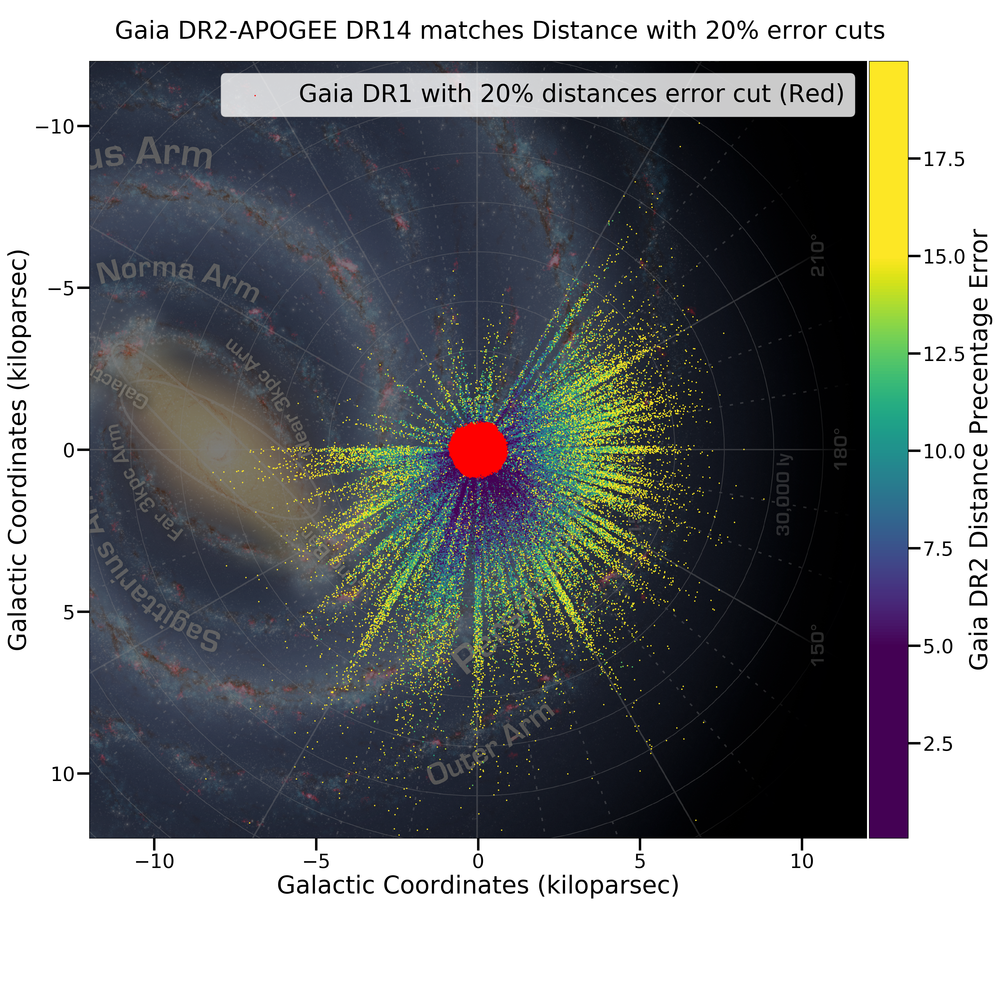
You can set the coord to galactic to plot observation from Gaia. Please notice if you are using astropy’s coordinates transformation, they will transform under left handed frame, you have to set x = -x to flip it to right handed which is also the expectation of mw_plot
from mw_plot import MWPlot
from astropy import units as u
import astropy.coordinates as apycoords
import numpy as np
from astroNN.gaia import gaiadr2_parallax
from astroNN.gaia import tgas_load
# To load Gaia DR2 - APOGEE DR14 matches, indices corresponds to APOGEE allstar DR14 file
ra, dec, parallax, parallax_error = gaiadr2_parallax(cuts=True, keepdims=False)
distance = 1 / parallax * u.kpc
ra = ra * u.deg
dec = dec * u.deg
distance_err = parallax_error / parallax
c = apycoords.SkyCoord(ra=ra, dec=dec, distance=distance, frame='icrs')
# Gaia DR1
# To load the tgas DR1 files and return a dictionary of ra(J2015), dec(J2015), pmra, pmdec,
# parallax, parallax error, g-band mag
# cuts=True to cut bad data (negative parallax and percentage error more than 20%)
output = tgas_load(cuts=True)
ra1 = output['ra'] * u.deg # ra(J2015)
dec1 = output['dec'] * u.deg # dec(J2015)
distance1 = 1 / output['parallax'] * u.kpc
distance_err1 = output['parallax_err'] / output['parallax']
c_dr1 = apycoords.SkyCoord(ra=ra1, dec=dec1, distance=distance1, frame='icrs')
# setup a MWPlot instance
plot_instance = MWPlot(radius=12 * u.kpc, unit=u.kpc, coord='galactic')
# so that the colorbar will has a better contract
plot_instance.clim = (5., 15.)
# alpha value for the milkyway image
plot_instance.imalpha = 0.5
# set up plot title
plot_instance.title = 'Gaia DR2-APOGEE DR14 matches Distance with 20% error cuts'
# use mw_scatter instead of scatter because we want a colorbar
# need to flip the sign of x because astropy is left-handed but mw_plot is right-handed
plot_instance.mw_scatter(-c.galactic.cartesian.x, c.galactic.cartesian.y,
[distance_err * 100, 'Gaia DR2 Distance Precentage Error'])
# On top of the main plot for DR2, plot DR1 too, need to flip the sign of x because astropy is l
# eft-handed but mw_plot is right-handed
plot_instance.scatter(-c_dr1.galactic.cartesian.x, c_dr1.galactic.cartesian.y, c='r',
label='Gaia DR1 with 20% distances error cut (Red)')
# Save the figure
plot_instance.savefig(file='gaia.png')Or plotting with Gaia Source with RV catalog (No code is provided but you should be able to modify the code above to do that)
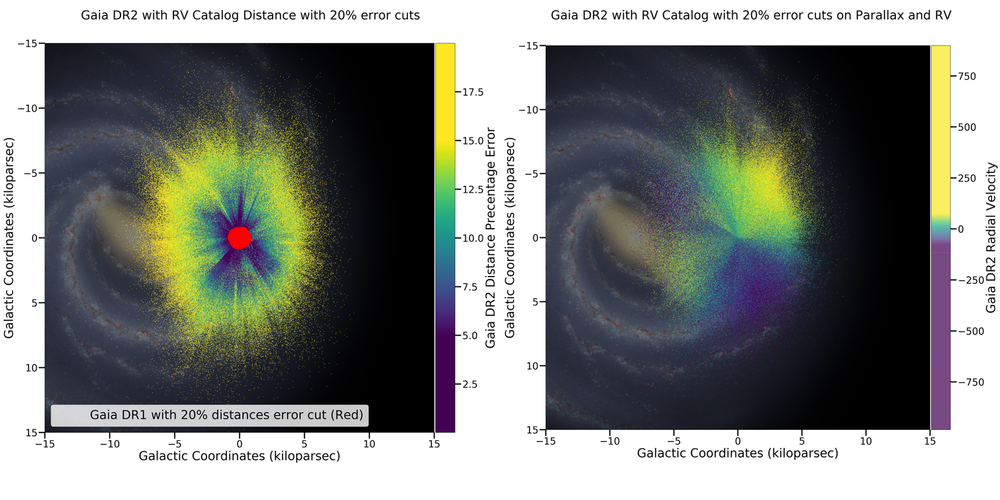
Example 2: Plot Dynamical Modeling of Tidal Stream using galpy
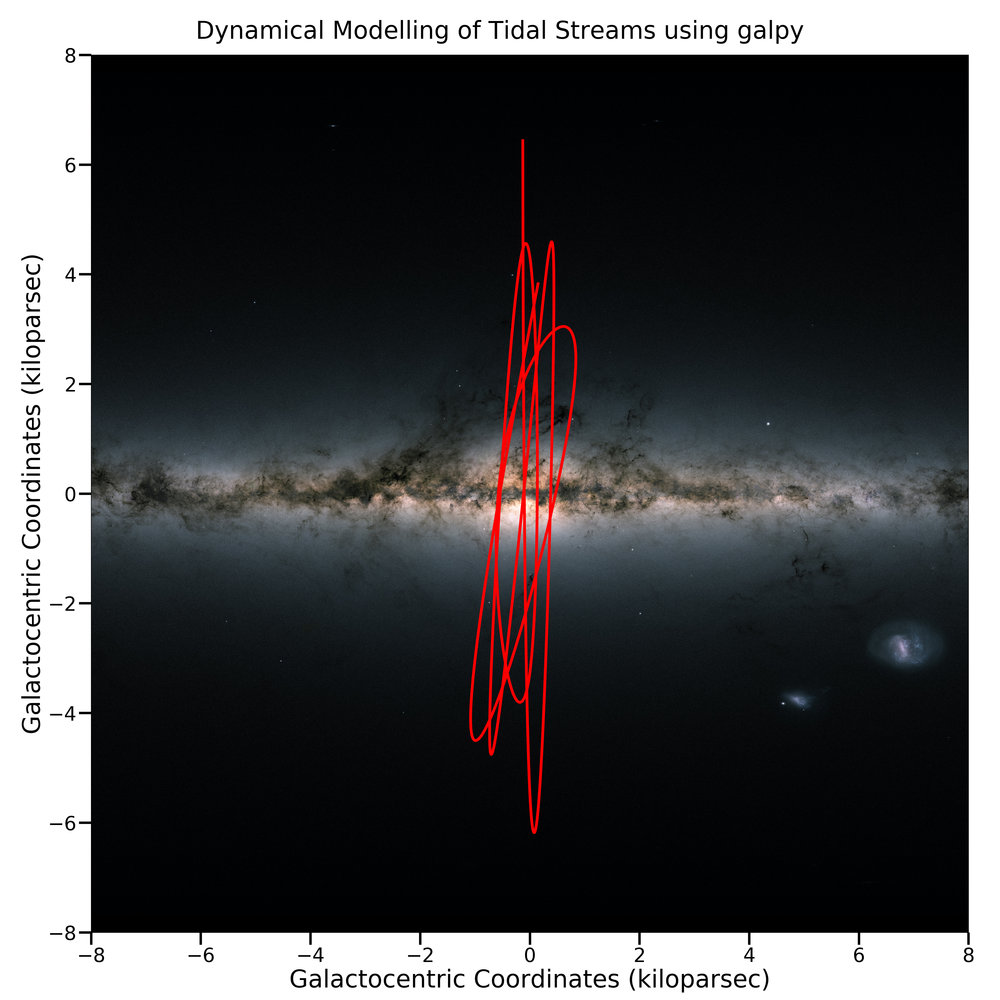
You can plot the orbit which are some scatter points on a edge-on milkyway
from mw_plot import MWPlot
from galpy.df import streamdf
from galpy.orbit import Orbit
from galpy.potential import LogarithmicHaloPotential
from galpy.actionAngle import actionAngleIsochroneApprox
from galpy.util import bovy_conversion # for unit conversions
from astropy import units as u
# setup potential
lp = LogarithmicHaloPotential(normalize=1., q=0.9)
# galpy tidal streams modeling
aAI = actionAngleIsochroneApprox(pot=lp, b=0.8)
obs = Orbit([0.16148083, 0.35081535, -0.15481504, 0.48719443, -0.27713334, 0.12019596])
sigv = 0.365 # km/s
sdf = streamdf(sigv / 220., progenitor=obs, pot=lp, aA=aAI, leading=True, nTrackChunks=11,
tdisrupt=40. / bovy_conversion.time_in_Gyr(220., 8.))
x = sdf._parse_track_dim('x', interp=True, phys=True)
y = sdf._parse_track_dim('y', interp=True, phys=True) * u.kpc
z = sdf._parse_track_dim('z', interp=True, phys=True) * u.kpc
# setup a MWPlot instance
plot_instance = MWPlot(mode='edge-on', radius=8. * u.kpc, unit=u.kpc, coord='galactocentric')
plot_instance.s = 10. # make the scatter points bigger
plot_instance.imalpha = 1.0
# set up plot title
plot_instance.title = 'Orbit of Sun in 20Gyr using galpy colored by kpc above galactic plane'
# plot line of the orbit with red color and thicker line
plot_instance.plot(y, z, c='r', linewidth=4.0)
# Save the figure
plot_instance.savefig(file='tidal_streams_plot.png')Example 3: Plot Orbit of Sun Integrated by galpy
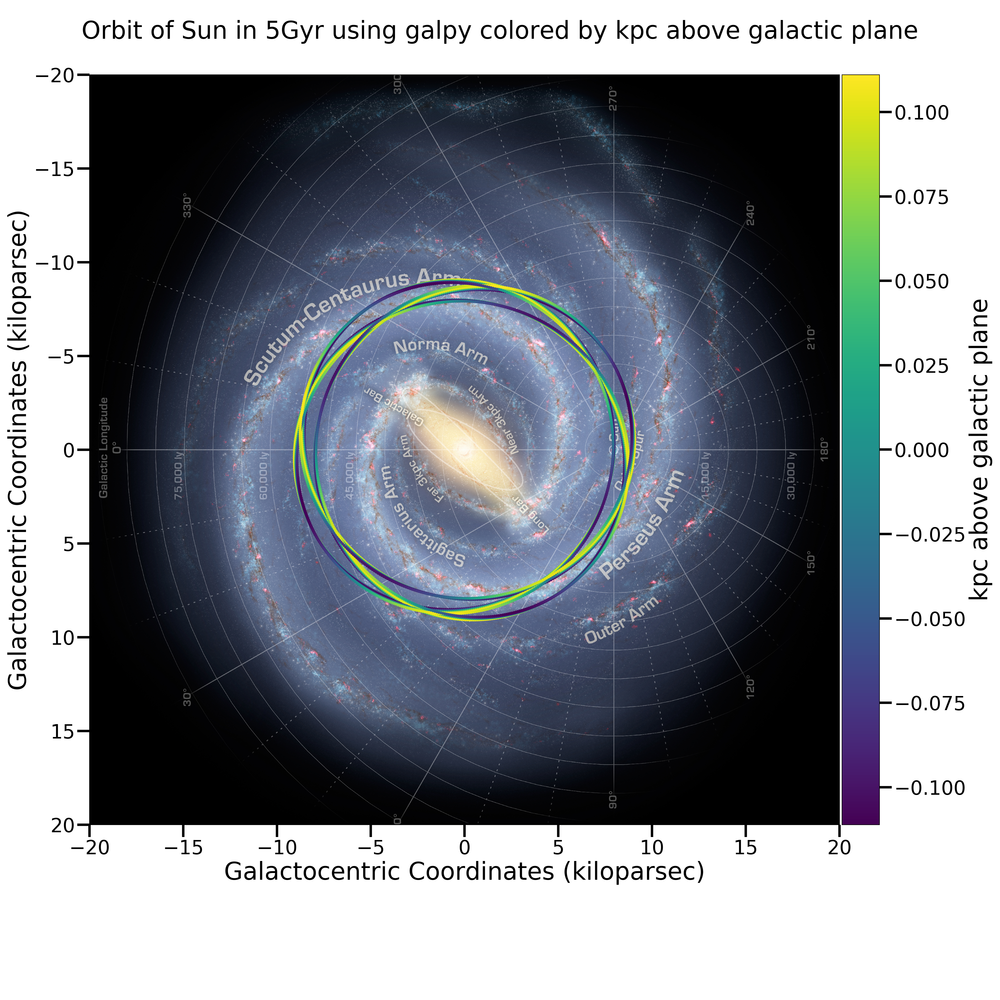
You can plot the orbit which are some scatter points on a face-on milkyway
from mw_plot import MWPlot
from galpy.potential import MWPotential2014
from galpy.orbit import Orbit
import numpy as np
from astropy import units as u
# Orbit Integration using galpy for the Sun
op = Orbit([0., 0., 0., 0., 0., 0.], radec=True, ro=8., vo=220.)
ts = np.linspace(0, 5, 10000) * u.Gyr
op.integrate(ts, MWPotential2014)
x = op.x(ts) * u.kpc
y = op.y(ts) * u.kpc
z = op.z(ts)
# setup a MWPlot instance
plot_instance = MWPlot(radius=20 * u.kpc, unit=u.kpc, coord='galactocentric', annotation=True)
plot_instance.imalpha = 1.0
plot_instance.s = 10 # make the scatter points bigger
# set up plot title
plot_instance.title = 'Orbit of Sun in 5Gyr using galpy colored by kpc above galactic plane'
# use mw_scatter instead of scatter because we want a colorbar
plot_instance.mw_scatter(x, y, [z, 'kpc above galactic plane'])
# Save the figure
plot_instance.savefig(file='mw_plot.png')
# Show the figure
plot_instance.show()You can turn off the annotation by putting annotation=False when creating an instance
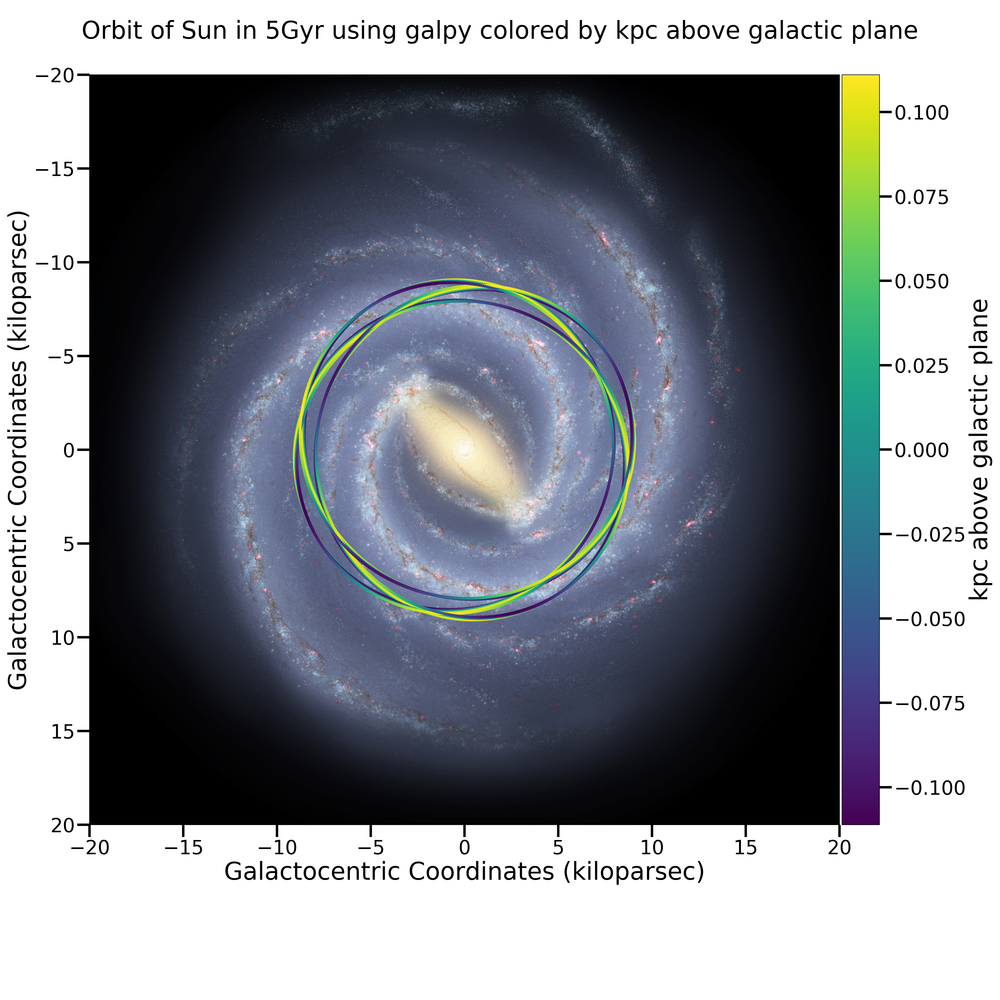
Example 4: Change the Center and Radius of the Plot
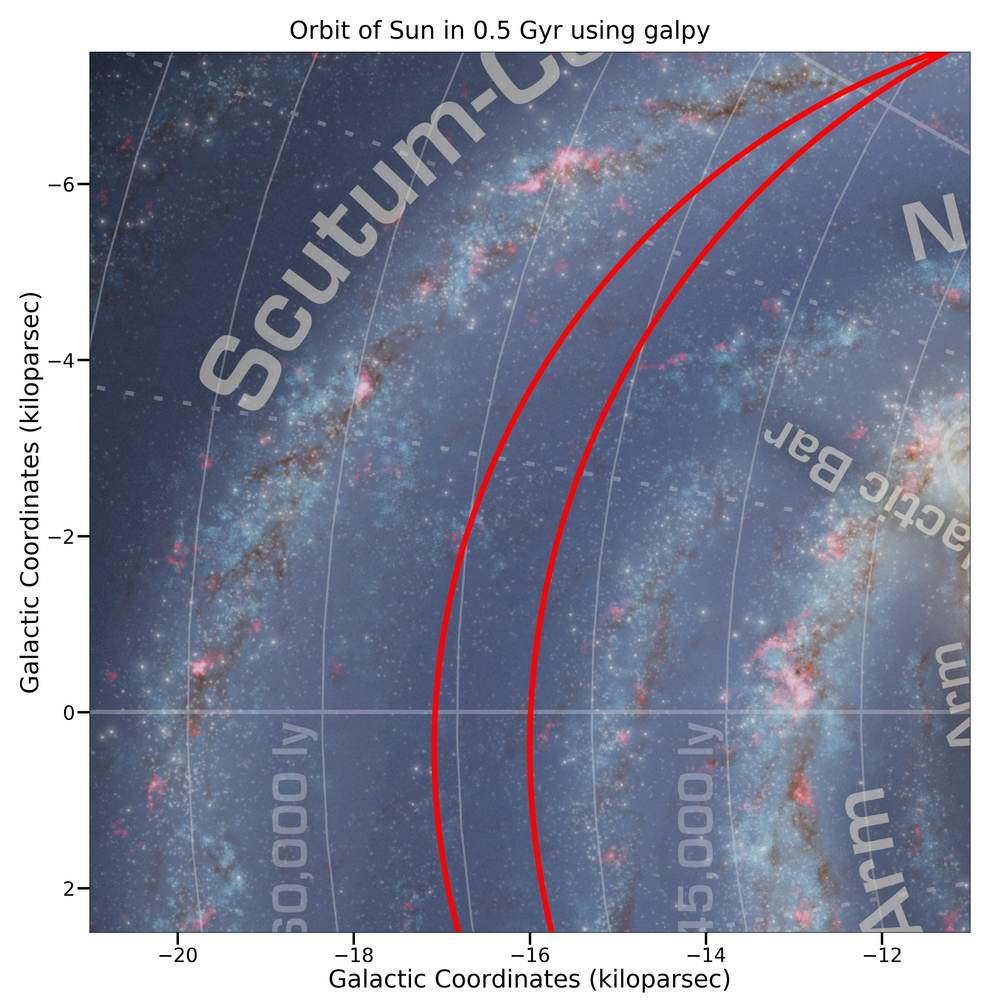
You can set the center point and radius of the plot. In this case, we set (-16, -2.5) in galactic coordinates such that the plot centered at the Sun at the end of 10Gyr orbit, and set the radius as 6 kpc to close up. We will just set the color to red without color bar title because there is no color bar needed. Please notice the plot assumed the milkyway is not moving.
from mw_plot import MWPlot
from galpy.potential import MWPotential2014
from galpy.orbit import Orbit
import numpy as np
from astropy import units as u
# Orbit Integration using galpy for the Sun
op = Orbit([0., 0., 0., 0., 0., 0.], radec=True, ro=8., vo=220.)
ts = np.linspace(0, 0.5, 10000) * u.Gyr
op.integrate(ts, MWPotential2014)
x = op.x(ts) * u.kpc
y = op.y(ts) * u.kpc
z = op.z(ts)
# setup a MWPlot instance with a certain center and radius
plot_instance = MWPlot(center=(-16, -2.5) * u.kpc, radius=5 * u.kpc)
# set up plot title
plot_instance.title = 'Orbit of Sun in 0.5 Gyr using galpy'
# plot, need to subtract 8kpc to shift to galactic coordinates in right hands frame
plot_instance.plot(x - 8. * u.kpc, y, c='r', linewidth=8.0)
# Save the figure
plot_instance.savefig(file='mw_plot_zoomed.png')
# Show the figure
plot_instance.show()Example 5: Plot all sky map
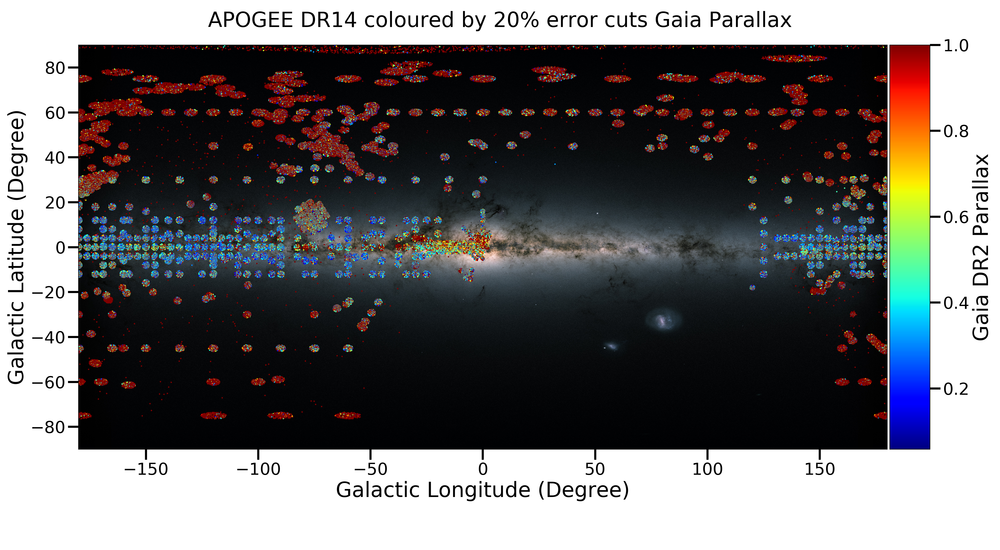
You can also plot all sky map with mw_plot’s MWSkyMap class
from mw_plot import MWSkyMap
import numpy as np
from astropy import units as u
import astropy.coordinates as apycoords
from astroNN.gaia import gaiadr2_parallax
ra, dec, parallax, parallax_error = gaiadr2_parallax(cuts=.20, keepdims=False, offset=0.00)
# setup a MWSkyMap instance
plot_instance = MWSkyMap(grid='galactic')
parallax[parallax>1] = 1.
# so that the colorbar will has a better contract
# plot_instance.clim = (5., 15.)
# alpha value for the milkyway image
plot_instance.imalpha = 1.
# setup colormap
plot_instance.cmap='jet'
# set up plot title
plot_instance.title = 'APOGEE DR14 coloured by 20% error cuts Gaia Parallax'
# use mw_scatter instead of scatter because we want a colorbar
plot_instance.mw_scatter(ra * u.degree, dec * u.degree, [parallax, 'Gaia DR2 Parallax'])
plot_instance.savefig(file='adr14_gdr2_skymap.png')
# Show the figure
plot_instance.show()License
This project is licensed under the MIT License - see the LICENSE file for details
Project details
Release history Release notifications | RSS feed
Download files
Download the file for your platform. If you're not sure which to choose, learn more about installing packages.











